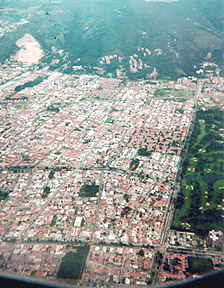
Aerial view
Santa Fe de Bogotá, Colombia (photo credit: R. Soong)
Transportation in Colombia

Aerial view
Santa Fe de Bogotá, Colombia (photo credit: R. Soong)
Modern society is based upon the division of labor. We recognize that each of us cannot hope to produce for ourselves all the things that we need and want. Consequently, we produce what we are good at and we exchange our productss for the other things. This principle holds for communists, socialists and capitalists alike, and what they argue about are the fairness and efficicacy of those exchanges.
Obviously, we want these exchange processes to take place quickly and efficiently, since they themselves do not necessarily possess consumption values. Transportaton is about moving people and goods from one place to another. A simple measure of the efficiency of transportation is the cost. As a crude measure, we may consider cost to be a direct function of the time spent traveling. The faster goods can be delivered from one place to the next, the more efficient it is. The quicker someone can get from one place to another, the more efficient it is. Now we have the following quantitative relationship:
(Time spent traveling) x (Speed of traveling) = (Distance traveled)
This seems to imply that there is a dual approach to reducing time spent traveling. We can reduce the distance between the origin and the destination and we can increase the speed of traveling. Unfortunately, these are conflicting objectives. Travel distance can be reduced by having very densely populated distribution points, where everything is near to everything else. Unfortunately, when the density is too high, the traffic is unlikely to move at all! Thus the streets become vast parking lots for vehicles that go nowhere.

Santa Fe de Bogotá, Colombia (photo credit: R. Soong)
A person typically has multiple options of getting from one place to another, subject to availability and affordablity. We will refer to some data from the TGI Colombia study, which is a consumer survey of 7,035 persons between the ages of 12 and 64 in Colombia conducted by IBOPE Columbia during 1999. Here are the percentages of people who use these popular methods of transportation.
% Persons 12-64 who have used the methods of transportation in the past seven days
| Bus / buseta | Taxi / colectivo | Private car | Bicycle | Foot | Motorcycle |
| 64% | 22% | 21% | 11% | 11% | 10% |
(source:
TGI Colombia, IBOPE Colombia)
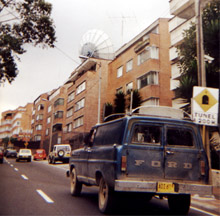 Santa Fe de Bogotá, Colombia (photo credit: R. Soong) |
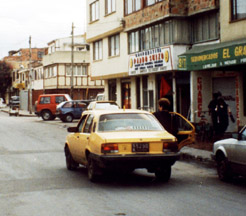 Santa Fe de Bogotá, Colombia (photo credit: P. Donato) |
There is some obvious segmentation of transportation choices. First of all, the spatial distributions of the population and the employment determine where people work, shop and conduct other business. Second, the spatial distribution of income also determines which types of transportation are more prevalent in specific areas. In the case of Bogotá, employment is high in the central district, the poor tend to live in the south of the city, especially in the outer rings, and the rich in the north. However, the long commutes faced by the poor is mitigated by the prevalence of flat, reasonable fares on public buses.
In the next table, we show the usage of different transportation methods by age/sex and by socio-economic level. In terms of the age/sex characteristics, it is clear that older people do not go around in bicycles and motorcycles, resorting to walking instead. Teenagers are the most frequent walkers, since their destinations are more likely to be in their immediate neighborhoods.
In terms of socio-economic level, the cost factor shows up clearly, as usage of taxis and private cars increased with socio-economic level, while traveling by bus and walking decreased.
% of Persons who used methods of transportation in past seven days, by age/sex and socio-economic level
| Bus / buseta | Taxi / colectivo | Private car | Bicycle | Foot | Motorcycle | |
| Male 12-19 20-24 25-34 35-44 45-54 55-64 Female 12-19 20-24 25-34 35-44 45-54 55-64 |
57% 74% 60% 56% 53% 57% 63% 70% 74% 68% 67% 64% |
20% 26% 18% 18% 18% 20% 24% 27% 22% 27% 20% 26% |
19% 18% 23% 25% 41% 23% 17% 20% 17% 21% 20% 14% |
26% 18% 24% 21% 7% 9% 11% 10% 8% 6% 5% 2% |
15% 5% 6% 8% 10% 12% 17% 8% 7% 11% 16% 13% |
13% 16% 16% 11% 7% 5% 11% 10% 8% 6% 5% 2% |
| Socio-Economic Level Alto (6,5,4) Medio (3) Bajo (2) |
56% 63% 69% |
30% 23% 18% |
40% 22% 12% |
10% 12% 10% |
8% 10% 13% |
10% 10% 9% |
(source:
TGI Colombia, IBOPE Colombia)
In looking at these statistics, we should be alert to the fact that what is listed as a method of transportation above may cover a wide range of configurations and varieties. For example, the term 'bus' can cover all types of public motor vehicles, including full-size buses (for 70 passengers), trolley buses (for 100 passengers), busetas (32 passengers) and microbuses (15 passengers). And the term 'private automobile' is not restricted to the image of a late-model sedan cruising along a freeway. So take a moment to look at the photos below. Were they what you had in mind before?
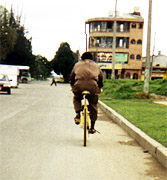 Bicyclist Bogotá, Colombia (photo credit: R. Soong) |
 Motorcyclist on a bumpy road Bogotá, Colombia (photo credit: R. Soong) |
 Three-wheeled motor van Bogotá, Colombia (photo credit: R. Soong) |
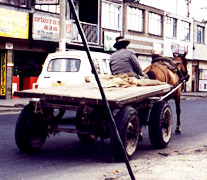 Horse-drawn carriage Bogotá, Colombia (photo credit: P. Verdin) |
(posted by Roland Soong on 2/16/00)
![]()
WWW LINKS
PRINT REFERENCES
(Return to Zona Latina's Home Page)